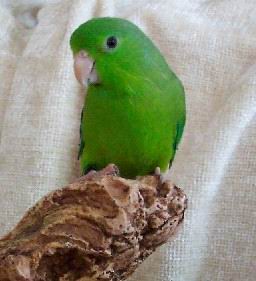Parrotlet - Sclater's
Schomburg's Parrotlet, Dusky Billed Parrotlet, Black Billed Parrotlet Scientific Name: Forpus sclateri sclateri
Fri, 4th July, 2025 - 5:06 pm GMT
Sponsor Ads:

Alternative Name
Schomburg's Parrotlet, Dusky Billed Parrotlet, Black Billed Parrotlet Scientific Name: Forpus sclateri sclateriBasic Info
Also known as Schomburg's Parrotlet, Sclater's Parrotlet usually grows to just over four and a half inches. They are a dark green in color and the lower back and rump of the male is a lovely deep violet color. The under wing coverts, the primary and secondary coverts, and the secondary flight feathers are also this blue- violet color. The secondary feathers are edged in green and the undersides of all the flight feathers are bluish green. The primary flight feathers are blackish and have outer webbing that is dark green. Generally, the heads of Sclater's Parrotlets are characterized by an emerald green color. The abdomen and breast are usually blue green and may be accented with olive green markings. Female Sclater's Parrotlets tend to have lighter plumage than the males. Usually, this means that the color is diluted with yellow. For example, the bluish green feathering of the male is translated in yellow green feathering in the female! The emerald green of a male's face is usually yellowish green in the female as well. The legs of Sclater's Parrotlet are brownish gray and the upper mandible is gray. The lower mandible of Sclater's Parrotlet is usually horn colored. Their irises are dark brown and the periopthalmic ring is gray.
Health
Sclater's Parrotlets should have a variety of perches available to them in places where the bird will not dirty its water should it utilize them. Parrotlets fed a pelleted diet should not have vitamin supplements, as this may overdose them on vitamins and cause health problems! Some Sclater's Parrotlets may not use hooded dishes. Breeding Not much is known about breeding Sclater's Parrotlets in captivity. Breeding pairs fed pellet diets should be supplemented with seeds, however, in addition to a powdered form of calcium.Habitat
N/ABehavior
Sclater's Parrotlet is a fairly rare, although charming little bird. These dark green parrotlets are truly a well-kept secret to those enthusiasts who know and adore them. Generally, Sclater's Parrotlets do well when kept alone because they may be fairly territorial or jealous! These birds will do well in wide cages or aviaries and, because they are intelligent, will need a variety of toys and chew items to prevent them from becoming bored. Of course, play time and cuddling with their owners has more amusement value than any toy! Sclater's Parrotlets will need fresh water at all times and should be fed a pellet diet or a good basic seed mix, supplemented with plenty of fresh fruits and vegetables. A cuttlebone or mineral block should usually be available as well. Sclater's Parrotlets seem to have a talent for flying even when their wings are clipped, so it is important not to let them run about freely out of doors! These playful little birds are amusing to watch and form strong, affectionate bonds with the person they spend the most time with when they are young and can even bond well with owners later in life! In the wild, Sclater's Parrotlets live in northern Brazil, eastern Peru, southeastern Columbia, and northeastern Ecuador.Origin
BrazilHistory
Sclater's Parrotlet has not been imported to the United States. It is better known in Europe, although even there it is not commonly kept. Sclater's Parrotlets are also known as Dusky Billed Parrotlets or Black Billed Parrotlets. They were first noted in nature by G.R. Gray in 1859. Although there is not much information available about Sclater's Parrotlets in the wild, it is not thought that their numbers are strong or even stable.Common Foods
N/ASponsor Ads:
An invasion of armies can be resisted; an invasion of ideas cannot be resisted. --Victor Hugo
Parrotlet - Sclater's
Coded by: BGID® | ALL RIGHTS RESERVED Copyright © 2000-2025
Disclaimer | Privacy | Report Errors / Contact | Credits
















